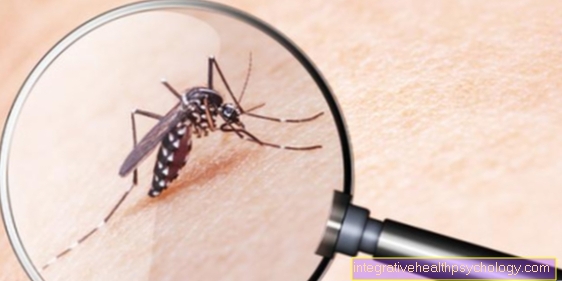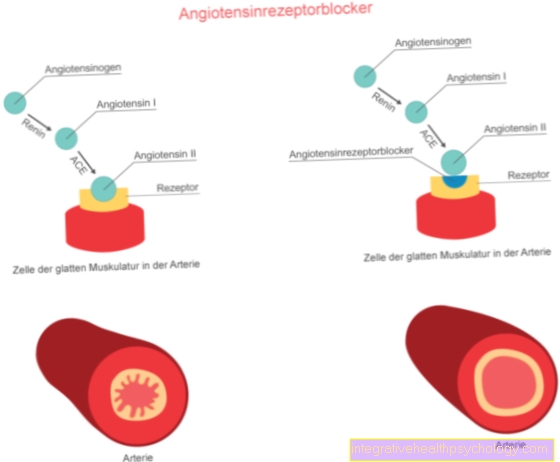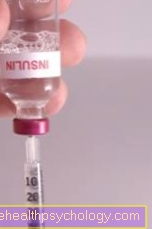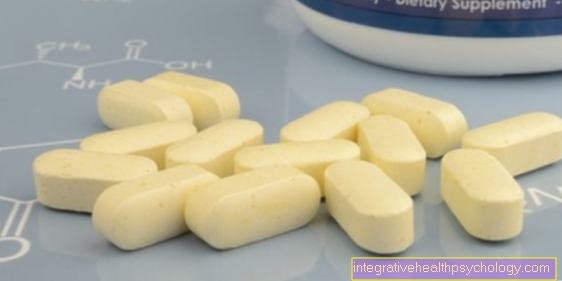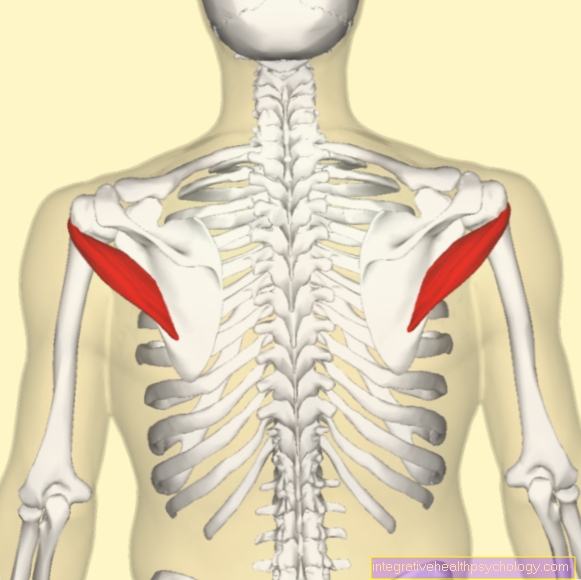Ferritin level too high
When is ferritin increased?
In general, one speaks of increased ferritin when the ferritin value rises above the normal limits for the respective sex and age. The limits are usually slightly higher, especially in childhood than in adulthood, and men have a significantly higher ferritin limit than women.
Limit values:
- Infants and newborns within the first six months of life: 200 ng / ml
- Children between six months and sixteen years: 150 ng / ml
- Adult age: women 160 ng / ml, men> 270 ng / ml
For more information on ferritin, see the following page: Ferritin

Reasons for increased ferritin
The reasons for an increased ferritin level are very diverse. Depending on the underlying disease, the increased ferritin can be harmless or very dangerous.
A harmless cause of the increase in ferritin occurs when there is inflammation in the body. The ferritin increases as a so-called acute phase protein along with other inflammation values in the body. Therefore, infections such as colds or the flu can quickly lead to increased ferritin.
Autoimmune diseases are also accompanied by inflammation in the body, so that they can cause the ferritin level to rise. Occasionally, malnutrition also leads to an increase in ferritin.
If the red blood cells (erythrocytes) are damaged, a large amount of iron can be released within a short time. In order to bind this iron, the body produces additional ferritin and thus increases the ferritin value. Occasionally, increased ferritin also occurs in the context of over-therapy with iron.
The causes of increased ferritin that are more in need of clarification are diseases of the liver. These can be iron storage diseases, but liver inflammation (hepatitis, liver cirrhosis) or liver tumors can also increase ferritin. When the liver cells are damaged, the ferritin stored in them is released into the blood, so that the measurable value in the blood increases.
Hemochromatosis is a condition associated with excessive iron absorption from the intestines. It leads to a chronic overload of iron and can consequently cause severe organ damage.
Can elevated ferritin indicate a tumor?
The increase in ferritin levels can basically indicate a tumor. In liver tumors in particular, ferritin can shoot up. The liver cells store a lot of ferritin, so that if liver cells are damaged by the tumor, ferritin can accumulate in the blood.
However, increased ferritin can also be the first indication of other tumors. Many tumors trigger a non-specific inflammatory reaction in the body. In the course of the disease, the inflammation parameters rise slightly, including acute phase proteins such as ferritin. If the ferritin level is elevated, the cause of the findings should therefore be clarified in order to detect serious illnesses at an early stage.
Our next topic might also be of interest to you: Symptoms of liver cancer
Diagnosis
The first stage of the diagnosis contains the anamnesis, in which typical symptoms can be asked by the doctor. The attending physician can often make assumptions about the causes of the increased ferritin concentration based on the anamnesis. A blood sample is then taken so that the blood values can be examined in the laboratory.
The most important value is ferritin. If this is above the age- and gender-specific norm value, the ferritin is too high. In addition, other values related to iron storage in the body are determined. These include the iron itself, the hemoglobin value (red blood pigment), the number of erythrocytes (red blood cells) and transferrin (iron transport protein).
Ferritin high but iron low?
There are few causes for increased ferritin in combination with decreased iron.
The most common reason for this is anemia (anemia), which is rare in our part of the world. Anemia describes the presence of too few erythrocytes and hemoglobin, this is usually due to a low iron value. In most anemias, the ferritin level is also low due to the iron deficiency.
In contrast, there are also typical representatives of anemia, which are associated with increased ferritin. These include, for example, thalassemia and microcytosis (Mediterranean anemia).
Find out more about microcytosis on the following page: Blood count
You can recognize elevated ferritin levels by these symptoms
The symptoms of increased ferritin are very much dependent on the diseases underlying the high ferritin value.
In the case of iron storage diseases, diseases such as cirrhosis of the liver and diabetes develop over time.
Liver cirrhosis manifests itself as a liver dysfunction, in which at first a weak performance and concentration difficulties are noticeable, later it can lead to jaundice (yellowing of the skin), water retention (edema) and skin changes.
At the beginning, diabetes usually manifests itself as an increased thirst and an increased urge to urinate. With this disease, too, symptoms such as tiredness and decreased performance often appear first.
The iron storage diseases can also manifest themselves in the form of joint pain. With an increased ferritin level, increased tiredness can generally be determined. In addition, stomach and abdominal pain can occur, and the skin occasionally turns dark. Some affected people also suffer from an intermittent palpitations, and occasionally a loss of libido (loss of sex drives) occurs.
Diseases such as hemochromatosis can cause severe organ damage over time, and the liver is particularly affected by the damage. The disease also significantly increases the risk of liver cell cancer.
Treatment of too high ferritin levels
The therapy for the increased ferritin value is initially carried out using so-called chelating agents. These are chemical complexes that are particularly suitable for binding iron. In this way, the increased iron usually associated with the increased ferritin value can be bound in the blood.
The chelating agents such as deferoxamine, after they have bound the iron, can be processed via the kidneys and thus excreted via the urine or also via the bile acids.
In addition, nutrition plays an important role in the therapy of increased ferritin. This should prevent the ingestion of too much iron from food. Affected people should avoid foods such as legumes, nuts, oatmeal and green leafy vegetables (e.g. spinach).
The intake of vitamins or minerals through dietary supplements must also be carefully checked, as they often also contain iron.
Vitamin C supplements should be avoided completely, as this vitamin promotes the absorption of iron in the intestine.
In order to treat hemochromatosis, which is associated with a particularly high ferritin value, the method of bloodletting is used. 500 ml of blood are taken weekly until the ferritin value has fallen below 50 ng / ml. This is followed by lifelong therapy with bloodletting from monthly to yearly.
forecast
The prognosis with increased ferritin is very much dependent on the cause of the disease. In the case of iron storage diseases, for example, if they are identified and treated early, consequential damage to organs can be avoided, so that the prognosis can be expected extremely well.
If the disease is not treated, the prognosis is very poor. Hemochromatosis also leads to a poor prognosis, especially if the liver is damaged, as the risk of liver cell cancer is greatly increased. Here, an early start of therapy cannot cure the disease, but it can prevent consequential damage.
Course of disease
The course of the disease with an elevated ferritin level, like the prognosis, is heavily dependent on the cause of the disease.
Usually symptoms such as headache, fatigue and poor performance appear first. Later, more severe symptoms such as dark skin discoloration appear.
In the course of time, without therapy, the organs (especially the liver) are damaged. This damage to organs leads to liver dysfunction, which can be seen as ascites (water retention in the abdomen) and jaundice (yellowing of the skin). In the worst case, the liver is so badly damaged that life-threatening conditions can arise. Some people can also develop liver cell cancer, which is also due to damage to the liver cells. This is also a life-threatening consequential damage.
Most of these organ damage can, however, be avoided by an early adequate therapy of the high ferritin.








